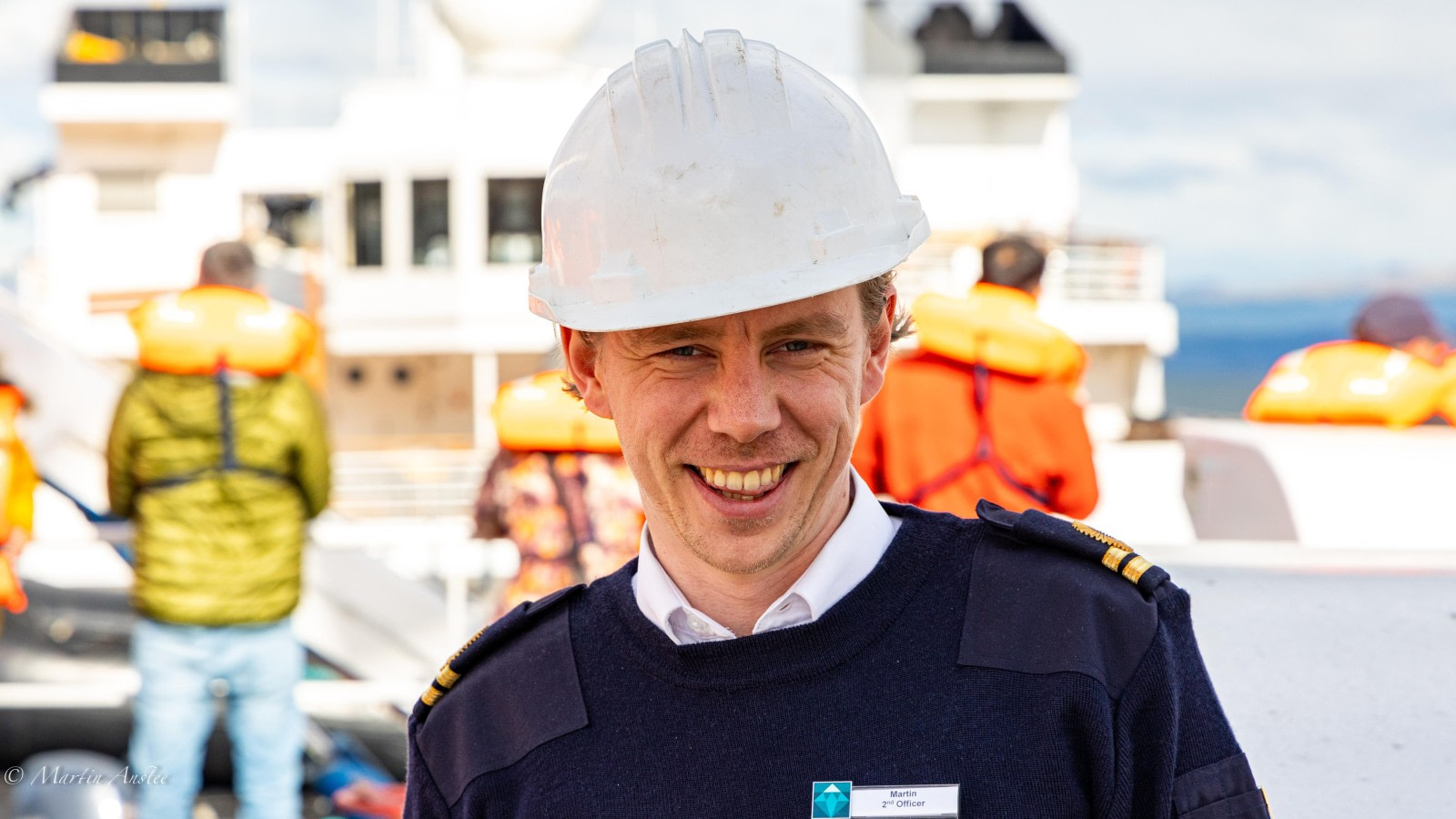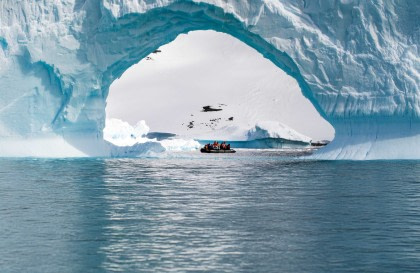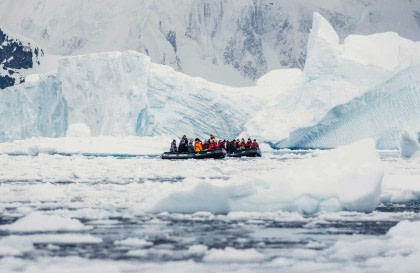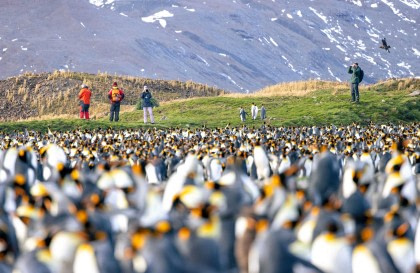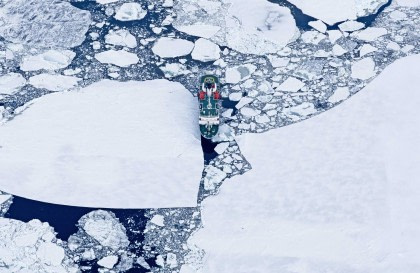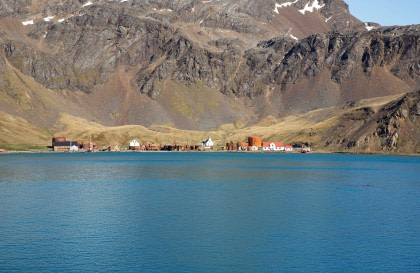During a voyage to the beautiful Scoresby Sund in Greenland, we spoke with Martin Hansson, Second Officer aboard m/v Ortelius about life on board, and the joy he finds in exploring the Earth's polar regions.
It's a sea day on Ortelius, and the ship is steadily heading south across the Denmark Strait, cresting the gently rolling waves, accompanied by a small group of gulls and petrels, soaring high above the bridge, or diving down before the bow, swooping across the water and rising back up alongside the hull of the ship. The temperature is cold out on deck, with a strong wind blowing from the west beneath clear skies, but on the bridge, it's warm, with the relaxed atmosphere of a final day at sea.
Martin Hansson, the second officer on Ortelius, is on duty, gazing out over the expanse of ocean surrounding the ship. "I've always loved reading about explorers, the travels of James Cook and Magellan, discovering the far corners of the world," he says. "When I was younger, I fell in love with those stories, and when I grew up, I was sad; I thought there was nothing left to discover or to experience. But here, on these ships, in these parts of the world, it's obvious that there's so much we still don't know. I feel like a true maritime explorer when I come to the polar regions."
Our vessel, Ortelius, really feels like an expedition ship. Rugged, with a storied history tied to research and scientific study and boasting a helicopter deck and ice-strengthened hull, she certainly looks the part, adding to the sense of adventure that has lain heavy throughout the trip. "For me, every voyage is a trip of exploration," Martin continues. "We visit places many people haven't been to before; for instance, we visited at least ten places new to me on this trip. That's one of the reasons I love this job so much - I am living out my dreams of exploring when I was younger."
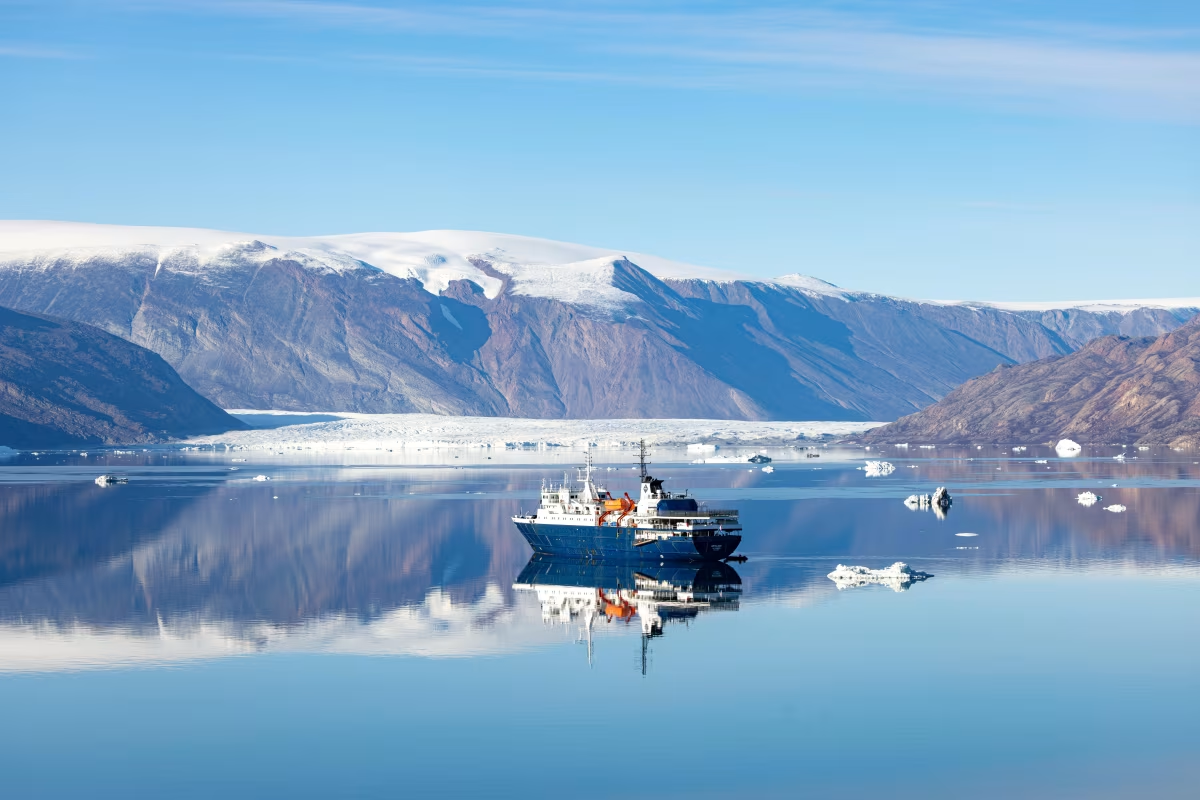
Picture by Martin Anstee
The past few days have been an unforgettable adventure through the iceberg-laden waters of Scoresby Sund, an extensive fjord system on the northeast coast of Greenland. First charted by William Scoresby in 1822, it remains wild, remote, and relatively undisturbed. "To be able to travel, almost in the footsteps of those past explorers, is just fantastic," Martin says. "When you're here, in Greenland, or the far south, in the Weddell Sea, or the Antarctic Peninsula, you can't help thinking of those early explorers, in their wooden ships, with no radar or electric radiators, and most of all, no warm coffee on the bridge!"
"When I take a moment and think about those stories and find myself where they happened - it's just so exciting to me - it keeps me coming back time and time again. And, I know many guests feel that same excitement and wonder in the stories of these regions." The same is true of Ortelius itself. Many guests return to Ortelius, season after season, joining her in Svalbard, Greenland, or the vastness of Antarctica. "People love this ship. I have seen people returning, specifically those who have chosen trips aboard Ortelius over others," Martin says. "And she is a great ship, full of character and history, which is why I also love her. She's perfect for operating in the polar regions and looks the part - Ortelius looks like an expedition ship should. Currently, I work on both Plancius and Ortelius, both rugged, unique and very special."
The criticality of effective teamwork
Looking the part is one thing, but operating successfully in the polar regions certainly requires high skill and trust in the vessel and other crew members. These areas are remote, and while far from port, the vessel and crew must be entirely self-reliant. "We depend on one another," Martin agrees. "We might be distinct, the bridge and the engine room, or the deck crews and the hotel team on board, but we're all one team and need one another to do our jobs properly. When you consider that often, in these regions, charts are not accurate, and many areas are not well surveyed, you need to be on top of your game every day. And that's true of us up here on the bridge and the guys below keeping us moving."
A well-oiled team working toward the same goals is essential for success at sea, especially on expedition cruise vessels, where complex logistics and careful planning are required to provide unforgettable guest experiences on land and at sea. "I like to think of the ship as one big ecosystem," says Martin. "Each team provides something essential that supports another, and at the core are our guests. Everything we do is for the guest experience and to keep them safe. People see the bridge team the most, as we have an open bridge policy on board - guests can come to see our work and ask questions. But there is a whole side of the ship that guests cannot see. For instance, the galley team works so hard to keep the crew and guests well fed, the hotel team behind the scenes, and then the rest of the crew on deck and below. Of course, guests spend much of their time with the expedition team, with whom we work closely to respond to weather, wildlife encounters, and other day-to-day updates and adjustments. But, the team is far bigger than that."
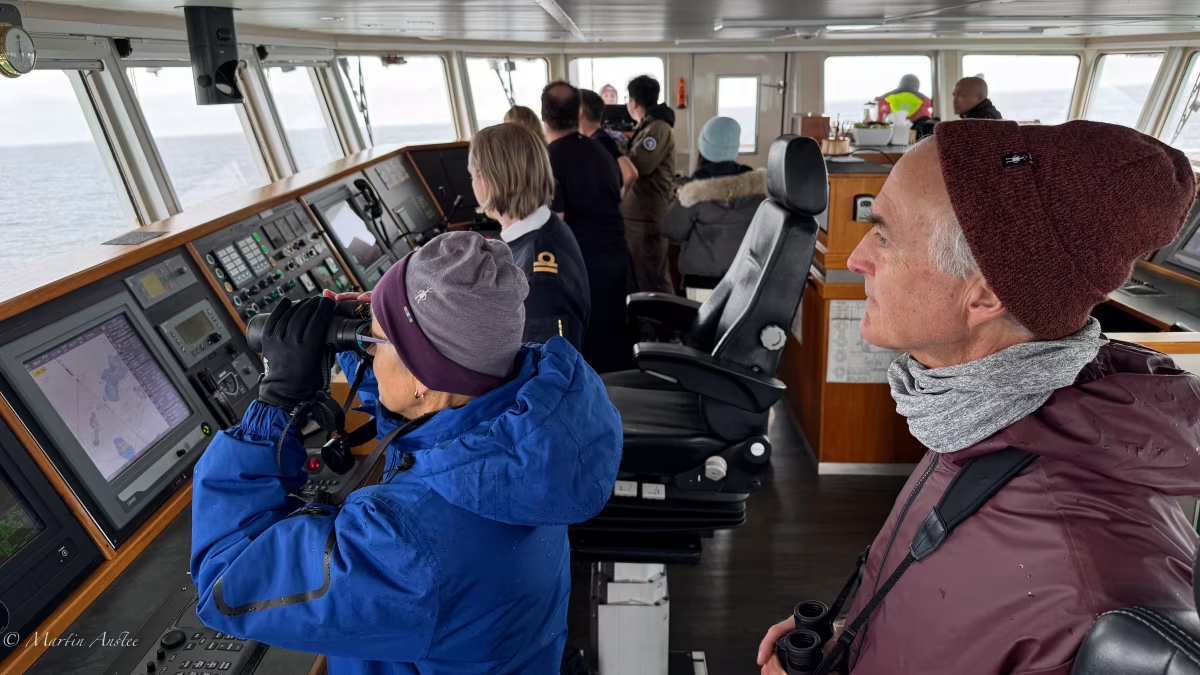
Picture by Martin Anstee
Martin's attention is required for a moment as the Captain of the Ortelius, Per Andersson enters the bridge. The ship's course will take us past Kolbeinsey, a tiny skerry jutting out of the ocean north of Iceland, and a plan is laid to lay just off it, providing a unique opportunity to witness this swiftly eroding islet and a chance to spot marine life that frequents the area. A brief discussion is held over charts and some of the displays that dot the bridge before Captain Andersson heads back out on deck, in discussion with another guest.
"I'm happy with how we work," continues Martin. "I've been working on ships for 10 years, working up through all of the deck ranks on small cruise ships and as a cadet on some expedition ships in Svalbard. I first got into the industry in the so-called 'Svalbard Fleet' in Gothenburg, first as a cadet, then as an Able Seaman (AB). From then on, I really had a drive to work on larger ships." Oceanwide's small expedition vessel fleet provides a balance between guest numbers, operational flexibility, and environmental impact compared to many other expedition cruise operators. "I joined the Kalmar Maritime Academy in Sweden, and after graduating, I worked on some small expedition vessels to Greenland," Martin adds. "For most of my cadetship, I worked on oil tankers and shuttle tankers, operating in the North Sea. But through it all, I had the desire to join the expedition industry."
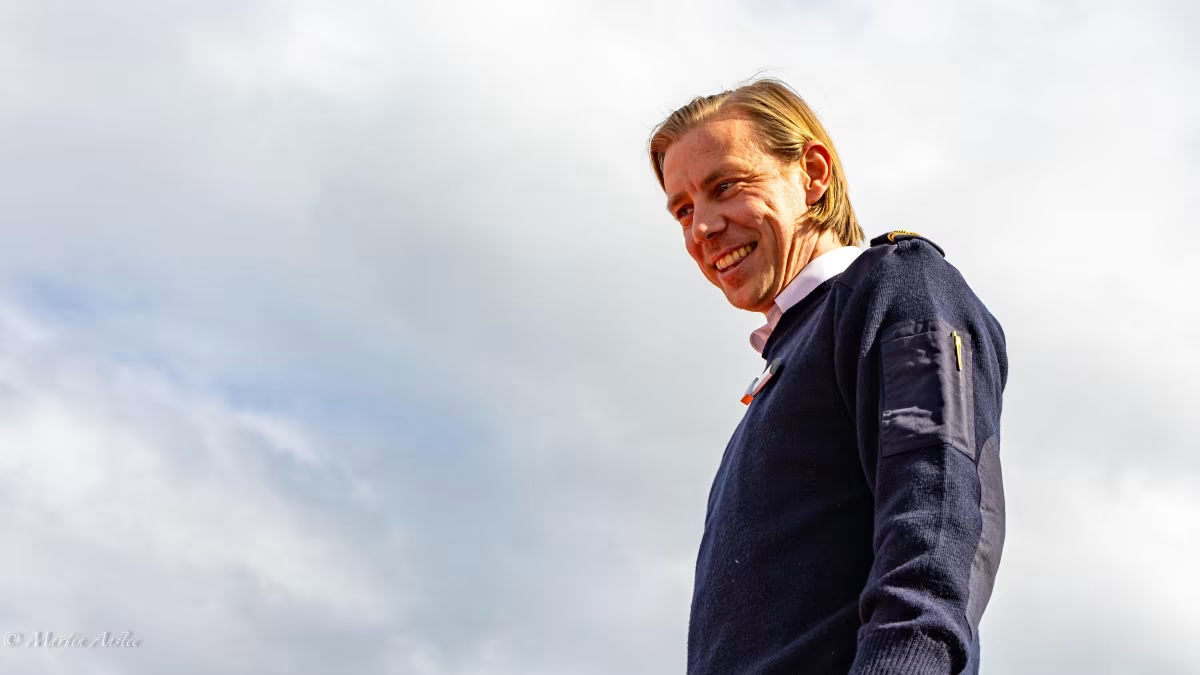
Picture by Martin Anstee
Following in the wake of past explorers
Like many in the maritime industry, Martin's career path hasn't always been direct. He recalls a moment, just before he joined Oceanwide Marine Services, the operating arm of Oceanwide Expeditions, where he was told on the gangway that he was the new ship's cook upon joining the crew of a cargo ship. "That was a bit of a shock," Martin laughs. "Especially given that my cooking isn't the greatest! But, quite quickly, I was promoted to Chief Officer, so that ended up being quite a career climb!"
"I think that working on shuttle tankers and oil tankers can be a comfortable job but boring for many. I felt that. When I had the opportunity to join Oceanwide, I jumped at the chance. I remember the phone call - 'we're going to Antarctica, do you want to come?' That was quite an easy decision," he says, smiling. "We work hard on board, but we also have the opportunity to experience these fantastic places alongside our guests, and for me, I get to live out my dreams of exploration as a child. What could be better?"
"We have a good bridge team, and it runs smoothly. We use a three-watch system across 24 hours, always with an officer and an AB. And, of course, we have the Captain; he doesn't have a set watch - he is always on call and ready to come if necessary. He will be present during crucial activities such as docking, or, later today, when we approach Kolbeinsey. It's good to have that support and to be able to rely on one another."
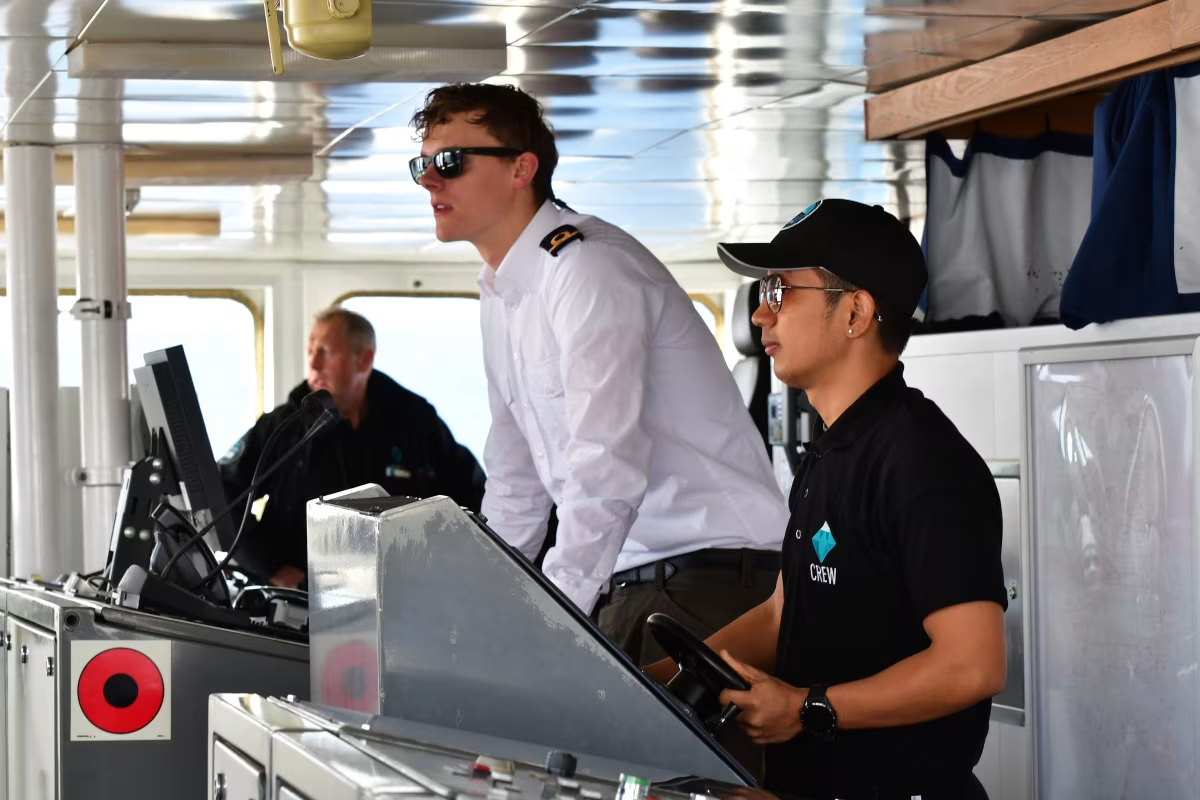
Picture by Hazel Pittwood
Throughout the trip, the bridge was open to guests, night and day. It was common to see guests on the bridge during the darkness of night, gazing out at the stars or the aurora that flashed overhead, during transit along fjords, or weaving past flotillas of icebergs. It has a certain appeal, an unmistakable aura. The bridge evokes the past, a glimpse into the realities of operating and exploring our planet's beautiful but unforgiving parts. "It has a mystique about it for sure," agrees Martin. "I am a seafarer, so I love the sea, ships, and everything that comes with it. But the difference here is that everything is so tangible - we have to navigate properly, we have to touch the controls, and understand our charts and the areas we find ourselves in. On oil tankers, out at sea, navigation is minimal."
"And for guests, they also sense that. They feel a part of a real adventure. Here, you can feel yourself in this amazing world. We're pushing the edges of the map alongside our guests, and they love it. Even on days when the wind howls and you feel the full force of the polar weather, the passion of everyone on board shines through. Sometimes, I pinch myself: we're on a polar expedition. When I see an iceberg, glacier, whale, or polar bear, the excitement floods back. And I love seeing guests having those same moments of wonder."
Main image by Martin Anstee
